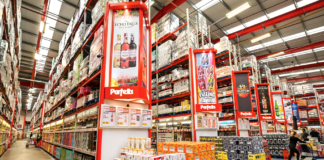In November, Mike McGee outlined how wholesale has developed a body of belief and terminology over the years that can be somewhat misleading and, in some cases, damaging to ongoing business. Following on from his examination of the customer in the first article, he now turns his attention to products.
Look at any promotional leaflet or in-store display and it is always the best-selling lines that are featured. It’s perfectly natural, of course, as these are the stock-keeping units (SKUs) that customers want. In a highly competitive market, these are the lines that are discounted to drive footfall.
When depot managers survey the queues at their tills and see customers loading their vans, they will focus on these individual lines purely because they are so very visible due to their sheer volume. From here, it is but a small leap to believe that these volume SKUs drive the category.
Often, however, nothing could be further from the truth. We recently worked with a well-known supplier that operates in a category where an own-label is the biggest selling SKU and dominates category thinking in depots. The own-label product was featured prominently, given most space and heavily pushed to customers.
What we could demonstrate, though, was that while this might well be the biggest SKU, it was not the biggest brand. In fact, our client had a range of sizes, all of which sold well to a wider spectrum of customers. Most trolleys contained one or more of these products, but what depots were not seeing was a few trolleys piled high with a single SKU.
In this case, by taking a balanced approach and understanding, the total category margin is increased and customer needs are better serviced.
This leads us to the impact of core range, which seems to be all the rage at present. There have always been planograms, of course, with the symbols pioneering this work a very long time ago. This has now been extended into all facets of retail clubs and indeed just general advice – although by the by, how often are these highlighted on shelf or in a price list and order form?
Leaving aside the issue that when you look at their sprawling ranges, wholesalers don’t seem to think core range applies to them, my main question is: how is the core range arrived at and is it, in fact, really core?
There are comparatively few wholesalers with the resources to be self-sufficient in this area and, thus, they rely on supplier input. This can lead to some issues.
Core range is basically bought and sold, with suppliers funding the activity. Wholesaling has long relied on additional funded activity to gain terms and increase margin. But how can this square with giving customers allegedly impartial advice?
Are suppliers really the best judges? As the saying goes, if you get three statisticians considering an issue, you will end up with at least four opinions and that is certainly the case on range.
Quite naturally, a supplier will always want to maximise its number of SKUs and positioning in a core range. To do this, it will choose its most favourable set of ‘weapons’ from the choice of volume, value, IRI data, Nielsen data, shipment data, qualitative data, shopper research and so on – indeed, there is an almost endless list of options for it to consider.
Having a multitude of core ranges has exactly the opposite effect of what is intended, with no credence given to any them. It may be a big ask, but is there not a case for an independent adjudicator with consistent criteria to actually perform this task on behalf of the trade?
New products are another issue. Wholesalers complain when major new products are launched in retail first, but are they really justified? The hoops of getting a listing, negotiating fees and then pushing it through wholesaler to customer to consumer do not really make for a seamless transition from product launch to consumer cupboard.
It could just as easily be argued that the wholesale sector needs the multiple trade to make the market into which it can then move. Wholesale finds it difficult to educate consumers and build awareness; what it does do very effectively is satisfy consumer need through retailer proximity.
A classic wholesaler response when considering new products or facing a supplier asking for more facings is: “We haven’t got elastic walls, you know.” Well, even I can’t argue with that.
However, what I would claim is that even though space is a constraint, it is a constraint that is not valued. Some depots operate ‘one in, one out’ but that may be totally wrong and lead to lost sales and profit. It also doesn’t happen very often in practice, with space seemingly always found for that new line extension, provided that the money is right.
A measurement of profit per pallet space or facing would actually challenge many assumptions in the wholesale and supplier community. Space is arguably the most important resource for the wholesaler and yet in complete contrast with the multiple sector, little is known about what each square foot delivers. Revenue would be comparatively straightforward to measure but the key measure – margin – is not so simple.
The difficulty of arriving at a net price with all the various terms and lump sums involved says something for the transparency and complexity of the sector in itself. Yet to truly value space and understand the contribution of a line, there is really no alternative to addressing this.
Until this point is reached, those elastic walls better keep stretching.
Wholesale is a complex industry, as any new recruit to the sector will tell you. However, it is also a key route to market that would do an even better job if it challenged some of these areas to make itself even more effective.
For wholesalers, 2015 represents a year of great opportunity, with unlimited potential and scope for success ahead of us. I firmly believe that the greatest opportunity of all is to find ways of working closer with suppliers to better understand each other’s needs and those of our customers. This will not only bolster our offer and provide our customers with a continually improving service and range but will also enable our customers to prosper and be in better positions to take advantage of the many chances that may come their way.
In a similar vein, I think the biggest challenge facing suppliers during 2015 is to maximise the opportunities wholesale offers in both the convenience and foodservice sectors. The market has never before seen such changing dynamics of multiple volume and value losses, alongside such growth in convenience and foodservice. I implore suppliers to work with us to really take advantage of this unique situation the wholesale landscape presents us with. I have every confidence that we can replace the multiples’ lost volume.
Of course, when I talk about challenges for the sector as a whole, it would be impossible not to reference the tobacco display ban in April. Everyone in the sector recognises that this will have repercussions and it’s clear that we need to wait to see how the impact is felt across the industry. Once stores implement the changes and it becomes the norm, I fully expect sales to return to near normal. However, in-store staff training will be crucial to ensure the law is adhered to.
And of course, the on-trade industry remains under pressure. Pubs continue to struggle. To compete, they need a fresh approach, not only offering competitive pricing but also a great food offer.
At Landmark we recognise this and, as a result, we are advanced in our plans to provide a one-stop shop of food and drink for any type of on-trade premises.
As with all industries, what is essential for progress and success is that we embrace innovation and move with the times. We must grasp the many technological opportunities and focus on the future. Now is not the time to apply old-fashioned thinking or a fear of the unknown.
We all know that wholesalers make an enormous contribution to the UK in terms of creating jobs, supporting businesses, adding value and, most essentially, keeping supply lines open. We work tirelessly to overcome obstacles as they present themselves, such as winter weather, travel issues, supply shortages or industrial action. It is essential that this year, we raise awareness of the role we play and how integral it is to our nation’s success.
2015 is the year to shout about our successes and work together to make this year even better than last, and I really believe it will be.








